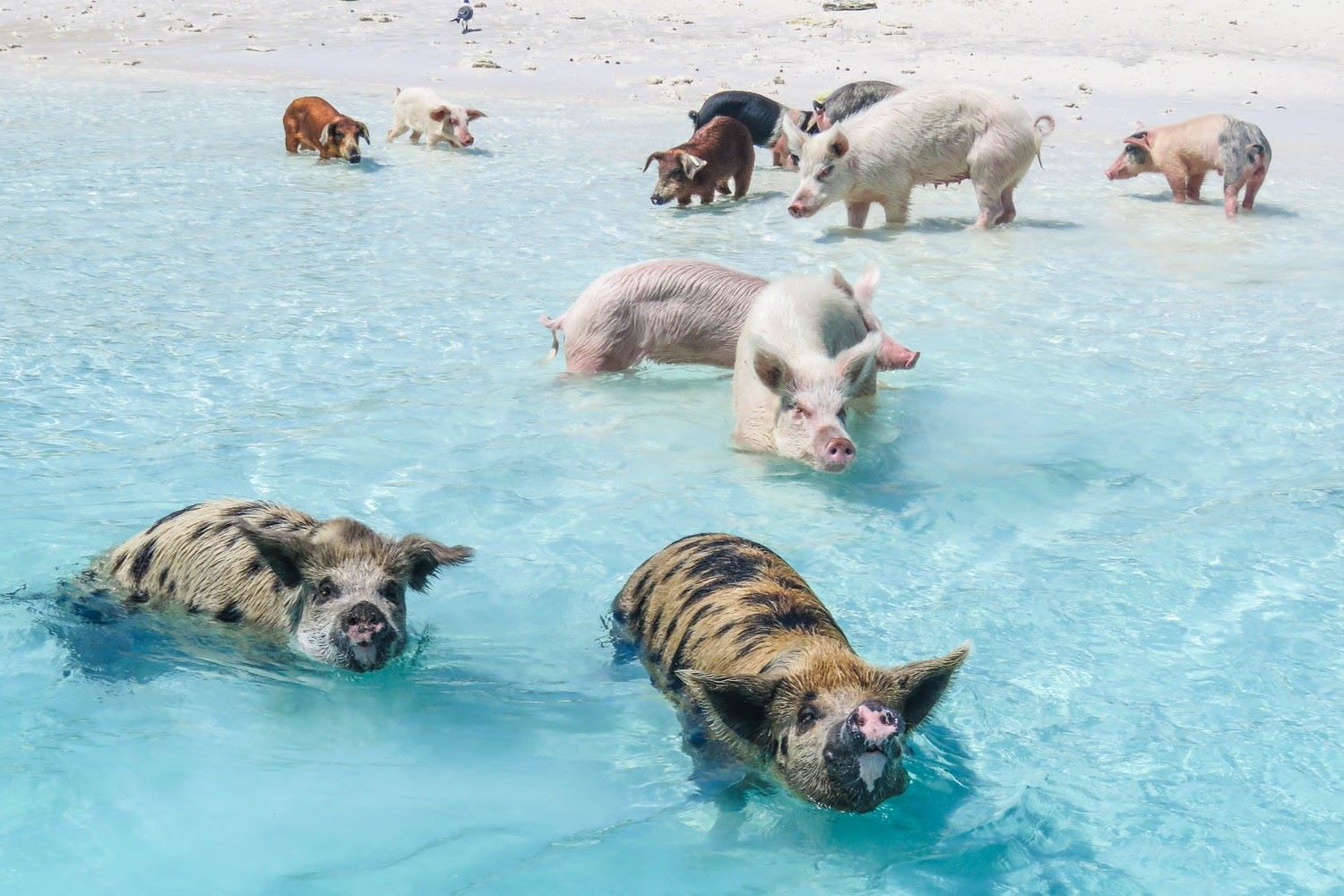
Why are pigs swimming in the Bahamas? Pig Beach, also known as Big Major Cay, is a unique island in the Exuma Cays of the Bahamas, famous for its swimming pigs. These semi-feral pigs have become a major tourist attraction, drawing visitors from around the world. The origin of these pigs is shrouded in legend, with theories ranging from shipwrecks to farmers relocating them to escape the smell. Today, over 20 pigs and piglets call this island home, thriving on food provided by tourists. While their presence has boosted tourism, it has also raised concerns about their welfare and the environmental impact on the island.
The Enchanting Location of Pig Beach
Pig Beach, also known as Big Major Cay or Pig Island, is a unique spot in the Bahamas. This small, uninhabited island is famous for its swimming pigs, which have become a major tourist attraction.
- Location: Pig Beach is situated on Big Major Cay, one of the 365 cays in the Exuma chain of islands in the Bahamas. The island's remote location adds to its charm and allure.
The Mysterious History of the Swimming Pigs
The origin of the pigs on Pig Beach is surrounded by intriguing legends and theories.
- History: One theory suggests that farmers from a nearby island brought the pigs to Big Major Cay to get rid of the smell they were causing. Another theory posits that the pigs were shipwrecked and swam to the island, creating a fascinating tale of survival.
The Unique Inhabitants of Pig Beach
The island is home to more than just pigs.
- Population: Big Major Cay hosts over 20 pigs and piglets, along with a few stray cats and goats. This diverse group of animals adds to the island's unique ecosystem.
The Pigs' Diet and Feeding Habits
The pigs' diet is largely influenced by the tourists who visit the island.
-
Diet: The primary diet of the swimming pigs consists of food fed to them by tourists. Fruits and vegetables are their preferred snacks, and guides usually provide safe food for visitors to feed them.
-
Feeding Habits: The pigs have become conditioned to associate the arrival of boats with feeding time. They eagerly swim out to greet visitors, expecting food.
Interaction with Humans
Despite being semi-feral, the pigs are quite accustomed to human interaction.
- Interaction with Humans: The pigs are used to constant human interaction and are generally friendly. However, visitors should treat them carefully and respectfully, avoiding actions like throwing, hitting, or riding the pigs.
The Pigs' Relationship with Water
The pigs have a unique relationship with the water around their island.
- Water Usage: The water serves as the pigs' shower and toilet. Visitors are reminded to keep their mouths closed while swimming to avoid any unpleasant surprises.
The Impact of Tourism
Tourism has had both positive and negative effects on Pig Beach and its inhabitants.
-
Crowd Attraction: Pig Beach is a popular attraction, often visited by celebrities such as supermodels, singers, and actors. This popularity brings crowds to the island.
-
Tourist Impact: Initially, tourism saved the pigs from slaughter by providing them a new home. However, it has also led to the pigs becoming dependent on tourists for food, raising concerns about their welfare.
Regulations and Care for the Pigs
There are no official regulations governing the treatment of the pigs, but local efforts help ensure their well-being.
-
Regulations: While there are no official regulations, local tour guides often keep visitors in check and provide safe foods to feed the pigs.
-
Natural Shelter: The island provides natural shelter for the pigs in the form of trees and bushes, protecting them from the sun and poor weather.
-
Fresh Water Supply: The pigs have a limited supply of fresh water on the island, which is supplemented by visitors providing them with fresh water.
Health and Safety Concerns
The pigs face several health and safety concerns due to their unique living conditions.
-
Sand Ingestion: Some pigs have passed away due to sand ingestion. Local officials urge visitors not to drop food on the beach or feed the pigs food covered in sand.
-
Visiting Hours: Most tours run from about 9 am to sunset. For some uninterrupted attention, visitors should consider going earlier in the morning when the pigs are more active.
-
Hurricane Season: The Exuma Cays, including Pig Beach, are in hurricane season from June to November. Locals take the pigs to safety when dangerous storms approach.
Tourist Activities and Ethical Concerns
Visitors can enjoy various activities on Pig Beach, but ethical considerations are important.
-
Tourist Activities: Visitors can swim with the pigs, explore the island, and interact with them on the beach. The experience is unique and enjoyable.
-
Ethical Concerns: Animal activists have raised concerns about the exploitation of the pigs for tourist attractions. Unsupervised tourists sometimes feed the pigs beer and other unhealthy foods, which can harm their health.
Conservation Efforts and Local Care
Despite the lack of official regulations, there are ongoing efforts to ensure the pigs' welfare.
-
Conservation Efforts: A nonprofit formed in 2018 ensures the pigs have a consistent fresh water supply and provides them with vitamins and food supplements.
-
Local Care: Locals bring food daily and ensure the pigs have fresh water, reducing their reliance on tourists for sustenance.
Pig Behavior and Health Concerns
The pigs' behavior and health are closely monitored by locals and visitors alike.
-
Tourist Behavior: Visitors are advised to behave responsibly around the pigs, avoiding actions like throwing or hitting them, not riding them, and staying clear of their mouths.
-
Pig Behavior: The pigs can be pushy around food, especially when hungry. Visitors should handle the pigs gently.
-
Health Concerns: The pigs are susceptible to skin cancer due to their exposure to the sun without protection. This is a significant health concern that needs addressing.
Population Control and Food Aggression
Managing the pigs' population and ensuring they receive adequate nutrition are ongoing challenges.
-
Population Control: The pigs can have up to 20 piglets each year, starting at just a year and a half old. Without population control, the island could become overcrowded, leading to health issues.
-
Food Aggression: When the pigs are hungry and not getting enough to eat, they become food-aggressive. This behavior indicates they are not receiving adequate nutrients.
Stress Levels and Environmental Impact
The pigs' stress levels and the environmental impact of their presence are important considerations.
-
Stress Levels: The pigs experience heightened stress levels when deficient in nutrients. This stress can manifest in aggressive behavior towards visitors.
-
Environmental Impact: The pigs' presence on the island has both positive and negative environmental impacts. While they contribute to the island's ecosystem, their dependence on tourists for food raises concerns about their long-term sustainability.
Broader Tourist Attractions in the Exumas
Pig Beach is part of a broader tourist attraction in the Exumas, offering visitors a variety of experiences.
- Tourist Attractions: Visitors can explore other sites such as nurse sharks at Compass Cay, sand bars at Pipe Creek, and underwater caves at Thunderball Grotto.
Accessibility and Best Time to Visit
Reaching Pig Beach and planning the best time to visit are key considerations for tourists.
-
Accessibility: The only way to reach Pig Beach is by boat. Private or rented boats can be used, and many guides are available for hire for day trips.
-
Best Time to Visit: The best time to visit Pig Beach is during the off-season (September to mid-November) when there are fewer visitors. The peak season is in December and January, but the weather may not be perfect during this time.
Tourist Impact on Environment and Regulatory Challenges
Tourism has both positive and negative impacts on the environment, and the lack of official regulations creates challenges.
-
Tourist Impact on Environment: Tourism brings economic benefits but raises concerns about the pigs' welfare and the island's ecosystem.
-
Regulatory Challenges: The lack of official regulations governing the treatment of the pigs creates challenges. Local tour guides often step in to ensure responsible behavior, but this is not a substitute for formal regulations.
Historical and Cultural Significance
Pig Beach has an interesting history and cultural significance that reflects the complex relationship between humans and animals.
-
Historical Significance: The pigs were initially brought to the island to alleviate a problem but have since become a major tourist attraction.
-
Cultural Impact: The swimming pigs have become a cultural icon in the Bahamas, attracting visitors from around the world. They are often featured in media and have been visited by celebrities.
Ongoing Conservation Efforts and Future Concerns
Despite the challenges, ongoing conservation efforts aim to improve the welfare of the pigs and ensure their long-term sustainability.
-
Conservation Efforts: Efforts include providing fresh water, vitamins, and food supplements to the pigs.
-
Future Concerns: The future of Pig Beach and its swimming pigs is uncertain. Ongoing conservation efforts are crucial to ensuring the long-term sustainability of this unique attraction. Responsible tourism practices are essential to balancing economic benefits with animal welfare and environmental concerns.
The Future of Pig Beach
Pig Beach is a unique spot that blends fun with important lessons about responsible tourism. The swimming pigs of Big Major Cay have become a global sensation, drawing visitors from all over. However, their well-being depends on how we treat them. Tourists should feed them properly, avoid harmful behaviors, and respect their space. Conservation efforts are crucial to ensure these pigs thrive without becoming too dependent on human interaction. Visiting Pig Beach offers a memorable experience, but it also comes with responsibilities. By being mindful of our actions, we can help maintain this special place for future generations. So, next time you find yourself in the Bahamas, remember to enjoy Pig Beach responsibly. It’s not just about the photos; it’s about preserving a unique piece of nature.
Was this page helpful?
Our commitment to delivering trustworthy and engaging content is at the heart of what we do. Each fact on our site is contributed by real users like you, bringing a wealth of diverse insights and information. To ensure the highest standards of accuracy and reliability, our dedicated editors meticulously review each submission. This process guarantees that the facts we share are not only fascinating but also credible. Trust in our commitment to quality and authenticity as you explore and learn with us.


